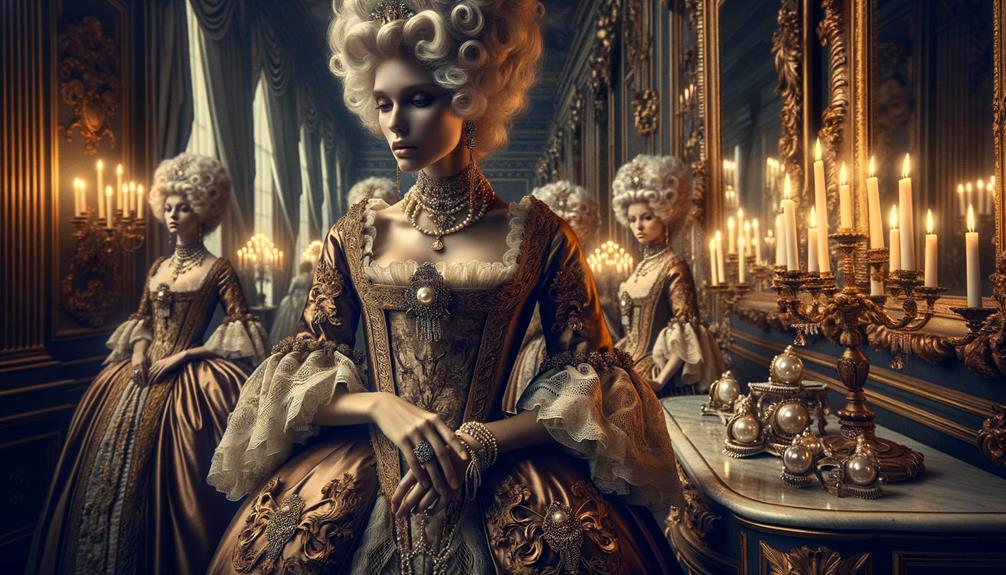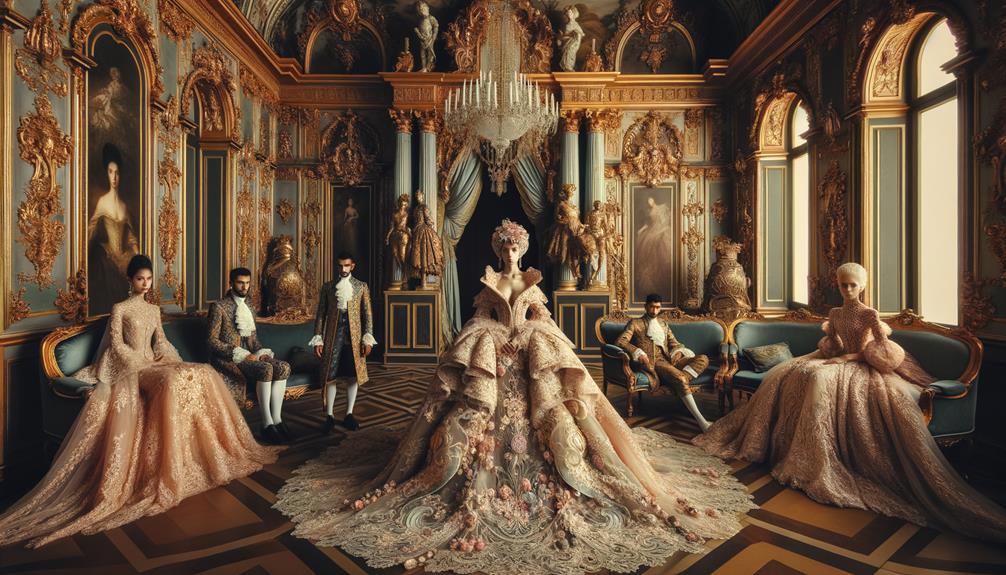The Baroque era's fashion was a lavish affair, draped in ornate lace and sumptuous velvet. Louis XIV's opulent attire mirrored his grip on power, while Marie de' Medici's gowns spoke volumes about her political savvy. Charles II's flamboyance wasn't just for show; it was a calculated move in the grand game of thrones. Queen Christina of Sweden and Catherine de Braganza challenged societal norms by blurring gender lines with their clothing choices. The Duchess of Montpensier embodied the Baroque spirit with her elaborate hairstyles and embroidered shoes. What drove these influential figures to such sartorial extremes?
Louis XIV: The Sun King
Louis XIV's reign brought a dramatic shift in French fashion, transitioning from the restrained elegance of the Renaissance to the lavish opulence of the Baroque era. Versailles, the French court, became a stage for extravagant displays of wealth and power. Clothing was a statement, with Louis XIV adorning himself in sumptuous silk, brocade, and ermine fur, commanding attention and projecting an image of authority.
The fashion of the Baroque period under Louis XIV was decadent. Ruff collars, once stiff and towering, softened and flattened against the neck, reflecting the intricate detailing of the era. This transformation was more than just aesthetic; it was a subtle assertion of control and sophistication. The French king's wardrobe became a blueprint for European fashion, with every stitch and fold meticulously curated.
Versailles was the epicenter of this sartorial revolution. Louis XIV's influence permeated every corner of the continent, and even centuries later, designers like Dior and Givenchy drew inspiration from this period. The Sun King's reign solidified France, and specifically Paris, as the fashion capital of Europe.
Observing Louis XIV, one sees the embodiment of Baroque opulence. His fashion choices were deliberate, each garment a piece of an elaborate, grandiose puzzle. Under his rule, the French court set the gold standard for European style.
Marie De' Medici
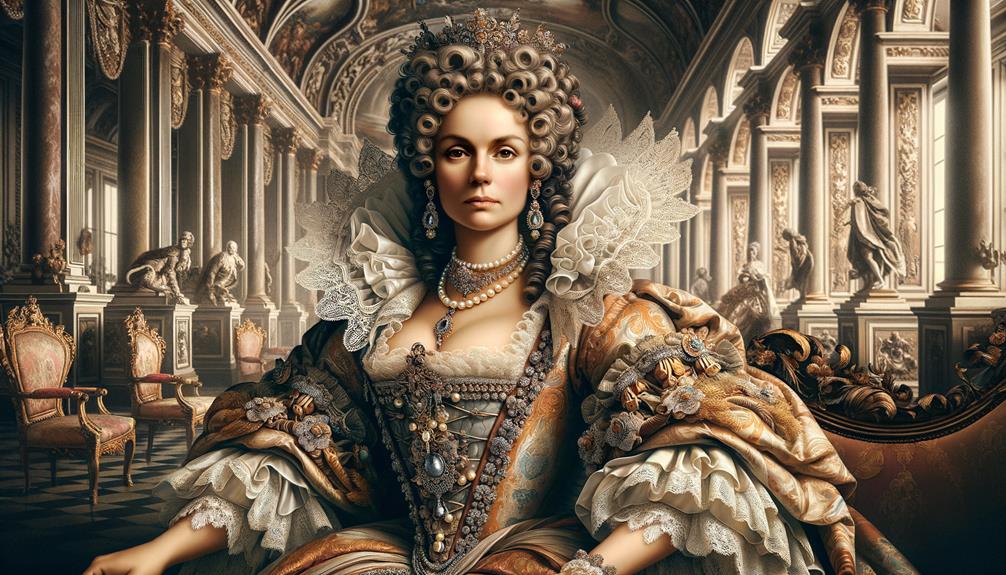
Marie De' Medici's fashion encapsulated the opulence and grandeur of the Baroque era. Her wardrobe became a symbol of extravagance, chronicling the lavish aesthetics of the period. Heavily embroidered gowns, dramatic headdresses, and ornate jewelry defined her signature look. Lace collars and cuffs adorned her outfits, drawing the eye to their intricate designs.
| Item | Description |
|---|---|
| Gowns | Heavily embroidered, opulent |
| Headdresses | Dramatic, lavish |
| Lace Collars | Intricate, adorned with lace |
Marie De' Medici's influence extended beyond just clothing. She wore her fashion as a form of armour, solidifying her status in the French court. Her choices helped establish the court as a center of Baroque style. Portraits commissioned by Medici serve as visual records of her elaborate ensembles, showcasing the period's focus on silhouette and opulence.
Wigs became an essential part of Medici's look, adding height and grandeur. Lace also grew in popularity, often worn in abundance. Under Medici's influence, the French court embraced these trends. The Baroque era, marked by excess, found its muse in Marie De' Medici.
Charles II of England
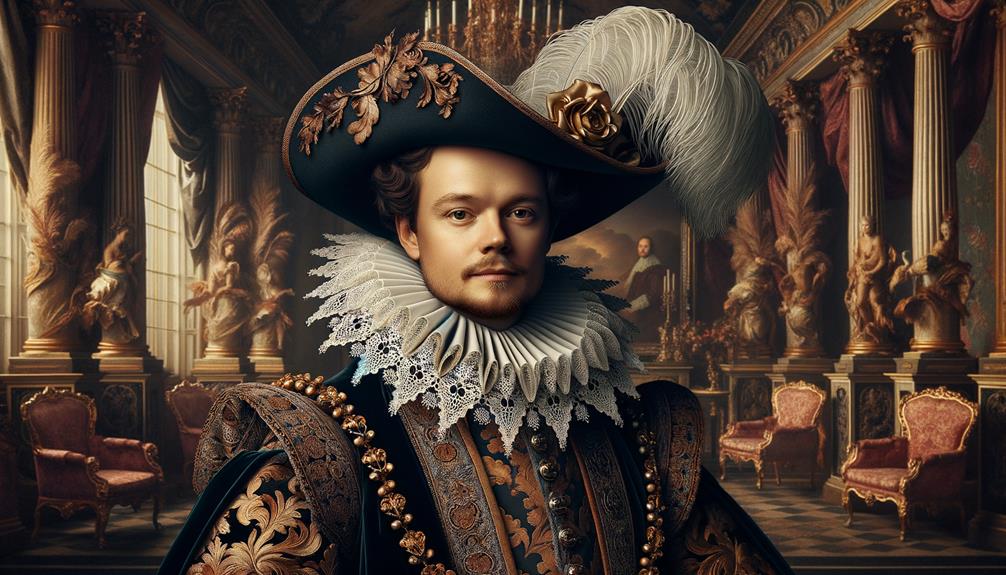
Charles II's reign brought significant changes to fashion patronage. He favored extravagant lace and velvet, setting new standards for Baroque men's attire that the court quickly adopted. This shift solidified these elements as key components of the era's fashions.
Royal Fashion Patronage
Few monarchs have left as indelible a mark on fashion as Charles II. His Carolean style redefined Baroque fashion, with a lasting impact on art and trends of the era. Women's clothing evolved, reflecting the elaborate, lush styles Rubens painted, known for their intricate textures. Silk garments became increasingly popular, echoing Charles II's opulent tastes.
Men's wear also underwent significant changes during this time. Breeches, coats, and waistcoats became the new norm as the period progressed. Charles II's preference for long hair and lace-trimmed attire revived these elements after the austerity of the Puritan years. His sartorial choices were a deliberate statement that resonated across Europe.
Charles II's lavish ceremonies, from his coronation to his wedding, showcased the grandeur of the Baroque era. These events solidified his status as a style icon, setting a standard that others aspired to. His influence extended beyond clothing, shaping the very aesthetic values of society and creating a lasting legacy in fashion.
Extravagant Lace and Velvet
The opulence of lace and velvet during Charles II's reign reflected the extravagant essence of Baroque fashion. The king's lavish taste was more than a personal quirk; it rippled through European style. His wardrobe was a symphony of textures and details, each piece telling a tale of extravagance.
Velvet doublets adorned with intricate embroidery, breeches festooned with ribbons and bows, elaborate wigs, lace cuffs and collars framing his face with elegance, and heeled shoes that elevated both stature and style – Charles II was not just a monarch, but a style icon.
His fondness for wide, loose-fitting breeches set against the structured rigidity of doublets created a dynamic silhouette that defined the Baroque style. The high heels he wore were more than just for height; they made an audacious statement. Every stitch, ribbon, and bow was deliberate.
Charles II popularized wigs, transforming them from mere necessity to symbols of opulence. Lace and velvet weren't just materials; they were declarations of status and taste. Through his sartorial choices, the king sculpted a legacy of fashion that still echoes through history.
Queen Christina of Sweden
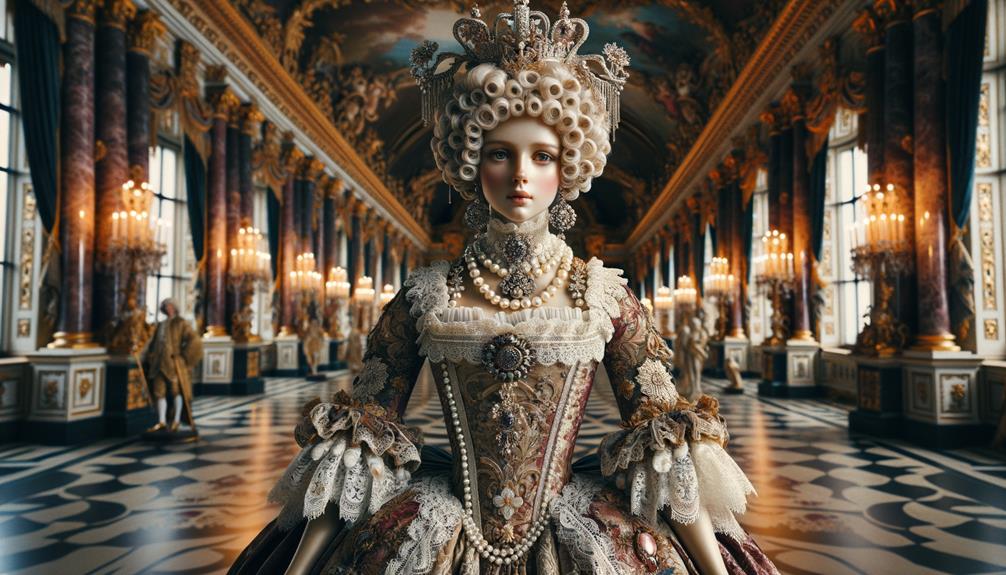
Queen Christina of Sweden's fashion choices challenged the rigid gender norms of her time. While women typically wore wide skirts trimmed with fur and low necklines with lace, Christina opted for breeches – a bold statement of defiance. She favored suits and short hairstyles, a stark contrast to the elaborate attire and coiffures of her contemporaries.
Christina's style was not just about clothing – it reflected her intellectual pursuits and fascination with classical and Renaissance aesthetics. Her unorthodox wardrobe made her a trailblazer in the Baroque era, as she wore what she wanted, how she wanted. This autonomy was central to her identity, carving a new path that defied expectations and embraced individuality.
Catherine De Braganza
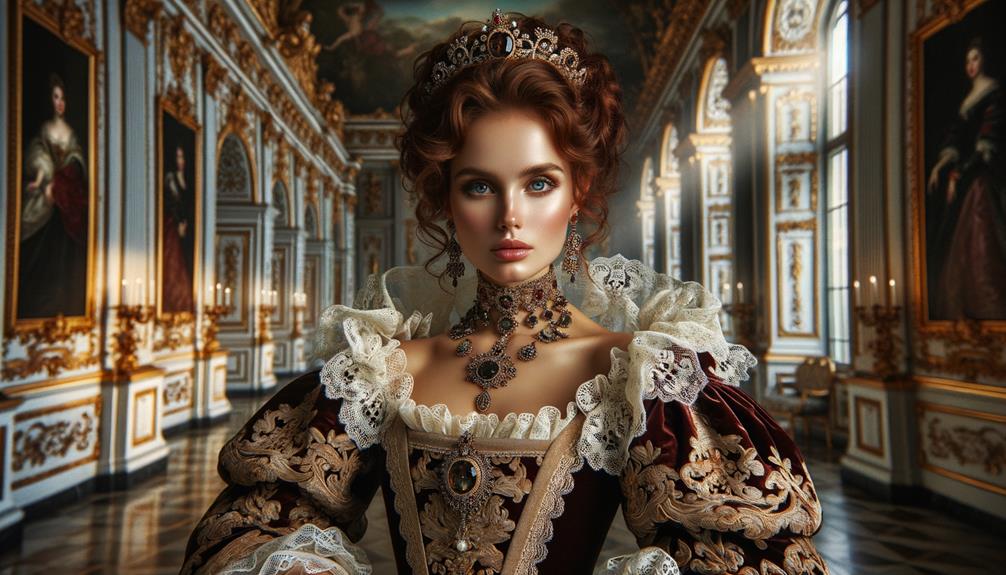
Unlike Christina's defiance of gender norms, Catherine de Braganza's influence stemmed from her embrace of lavish and ornate styles. As the Portuguese princess who married King Charles II in 1662, she brought with her an affinity for Baroque fashion. Women's attire reflected her taste for opulence and sophistication, featuring fine fabrics and lace collars.
Catherine's fashion choices quickly gained popularity:
- The "mantua dress" – a loose, open-fronted robe with a flowing train.
- Billowing, vibrant full skirts, often in red or purple.
- Detailed, elegant lace cuffs and collars.
- Lace ribbons adorning dresses for added flair.
- Intricate embroidery patterns showcasing wealth.
Her elegant wardrobe, rich in silk and velvet, solidified Baroque fashion's association with wealth and power. The pointed bodices and elaborate embroidery she favored captured the essence of the Restoration period's style. Catherine's influence extended beyond clothing; she introduced the custom of drinking tea, intertwining cultural refinement with sartorial elegance.
In a world seeking innovation, Catherine's embrace of fine fabrics and intricate details set a standard for high fashion. Her ability to popularize distinct elements in Baroque fashion left a lasting impact on the English court and beyond.
The Duchess of Montpensier
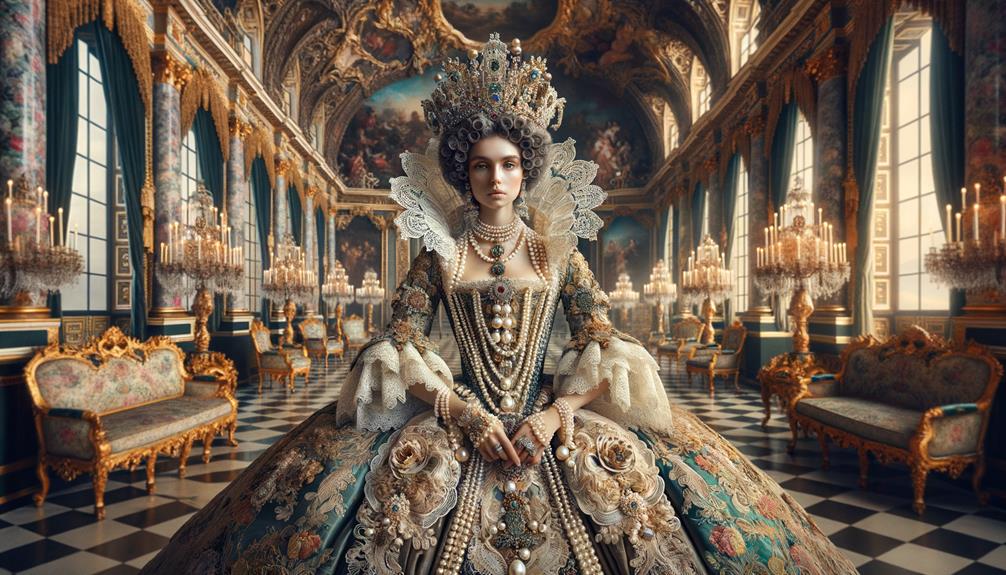
Amid the splendor of the French court, Anne Marie Louise d'Orléans, the Duchess of Montpensier, captivated all with her striking style. She navigated the intricate world of early Baroque fashion with a distinct flair.
Her elaborately styled hair, adorned with jewels, became hugely popular among the aristocracy. Women of the first half of the Baroque era began to emulate her grand hairstyles, tied with ribbons and pearls. Her gowns, often trimmed with ermine fur, exuded luxury and were crafted from fine linen. The Duchess's influence extended to women's shoes, which she often decorated with intricate embroidery and lace.
| Fashion Element | Influence | Popularity |
|---|---|---|
| Hair | Elaborate styles with jewels | Very popular |
| Gowns | Trimmed with ermine fur | Trendsetting |
| Accessories | Ribbons and pearls | Widely emulated |
| Women's Shoes | Embroidered and lace-adorned | Influential choice |
Portraits by Antoine Dieu showcase the Duchess's exaggerated Baroque silhouette: padded hips, wide sleeves, and a low, square neckline. Her fashion choices set trends that would become staples of French aristocratic attire. The Duchess of Montpensier's style was more than just opulence – it was innovation.
Frequently Asked Questions
Who Influenced Baroque Fashion?
King Louis XIV, known as the 'Sun King', had a significant influence on Baroque fashion. His lavish court set the trends that spread across Europe. Other notable figures like Madame de Pompadour and Queen Elizabeth I also played a role in shaping the styles of the time. Their impact was felt throughout the continent, guiding the evolution of fashion.
Who Influenced the Baroque Style?
The opulent Baroque style was shaped by influential figures like French King Louis XIV, Flemish painter Peter Paul Rubens, and England's Queen Elizabeth I. These historical powerhouses each contributed a distinct thread to the rich, ornate aesthetic, weaving together a grand, lavish tapestry.
Louis XIV's patronage of the arts and his lavish court at Versailles set the tone for the extravagant Baroque period. Rubens' dynamic, dramatic paintings exemplified the style's emphasis on emotion and movement. Meanwhile, Queen Elizabeth I's reign saw the rise of an ornate, grandiose architectural and artistic language that defined the English Baroque.
Through the vision and influence of these key historical figures, the Baroque style emerged as a bold, theatrical expression of power, wealth, and religious devotion. Its elaborate ornamentation and sense of grandeur left an indelible mark on the arts and culture of the 17th century.
Who Influenced Fashion in the Seventeenth Century?
In the seventeenth century, fashion was heavily influenced by figures like French King Louis XIV, his mistress Madame de Montespan, England's Queen Elizabeth I, and Cardinal Richelieu. Their styles ranged from ornate, lavish gowns to the sleek, tailored habit à la française suit.
King Louis XIV's opulent court in Versailles set the standard for high fashion, with towering wigs, heavy brocade fabrics, and intricate embroidery. Madame de Montespan, his powerful mistress, was known for her extravagant outfits that showcased the latest trends.
Meanwhile, Queen Elizabeth I of England maintained a regal image through her iconic gowns with large ruffs, jewel-encrusted bodices, and voluminous skirts. Cardinal Richelieu, a prominent French statesman, preferred the more streamlined habit à la française – a coat, waistcoat, and breeches ensemble that became a fashionable men's look.
These influential figures shaped the sartorial landscape of the 17th century, with their distinct styles reflecting the wealth, power, and cultural preferences of the era.
Where Did the Baroque Style Originate in the 17TH Century?
The Baroque style emerged from the heart of Rome in the early 17th century. It wasn't just an artistic movement – it was a cultural revolution that swept across Europe, reshaping the continent with its dramatic flair.
The Baroque style took Italy by storm, and its influence soon spread beyond the country's borders. This dramatic aesthetic left an indelible mark on European art, architecture, and even everyday life. Rather than a mere artistic trend, the Baroque represented a fundamental shift in how people perceived and interacted with their surroundings.
The Baroque's impact was far-reaching and undeniable. It transformed the visual landscape of cities, cathedrals, and palaces, ushering in a new era of grandiose, emotive design. But the Baroque's influence extended beyond the realm of the arts – it also reshaped cultural attitudes, ushering in a period of greater theatricality and opulence in all aspects of life.
Conclusion
Fashion in the Baroque era was more than just clothing – it was power, identity, and even rebellion. While some might dismiss it as frivolous, these style icons of the 17th century shaped culture and history in profound ways.
Louis XIV's lavish opulence, Christina's defiant persona, Catherine's refined elegance – they weren't simply dressing up. They were making bold statements that reverberated through their time. Even today, we can still feel their influence.
So next time you're tempted to write off fashion as mere vanity, remember: it was once a force that could change worlds. These icons used their clothes as tools of self-expression and transformation. Their sartorial choices were windows into their values, ambitions, and visions for society.
Fashion was never just about what was on the surface. It was a means of wielding power, asserting individuality, and challenging the status quo. The Baroque era proved that style can be a form of cultural currency – one that these pioneers spent wisely to shape the course of history.



